Looking to boost your app's visibility and acquire more users? Our 2025 ASO Report is your ultimate guide to navigating the evolving app store landscape. Packed with data-driven insights, keyword trends, and top-ranking app strategies, this report will equip you with the knowledge to optimize your app's presence and achieve organic growth.
App Store Optimization (ASO) refers to improving an app’s visibility and conversion in app store search results. A core part of it is ASO keyword research, which means identifying and targeting the search terms your audience uses to find apps like yours.
This matters because search remains the dominant way users discover apps; roughly 70% of app installs originate from app store searches. In other words, if you’re not optimizing keywords, you’re missing out on the majority of potential users.
As of 2025, the Apple App Store had over 2 million apps and Google Play nearly 4 million, and these numbers keep growing. More apps mean more competition for search rankings, so keyword research for ASO is essential to outrank competitors and get noticed.
In our ASO keyword research blog, we’ll present an up-to-date, data-driven framework to help you uncover high-impact keywords and sustain your app’s visibility.
We’ll walk through how to do ASO keyword research step by step, from initial brainstorming to continuous optimization. By the end, you’ll know how to find the right keywords and achieve better rankings for your app.
Key takeaways
- ASO keyword research remains essential in 2025, with millions of apps competing for visibility.
- Focus on search popularity, difficulty, relevance, and ranking to prioritize the most valuable and achievable keywords.
- Start with clear goals and user intent research how your audience searches for solutions.
- Combine competitive, high-volume keywords with long-tail phrases that capture intent and conversions.
- Translate keywords for different markets to connect with audiences worldwide.
- Track your performance regularly, update your keyword list, and adapt to trends.
- From discovery to monitoring and localization, MobileAction provides the all-in-one platform to make ASO keyword research faster, smarter, and more impactful.
What is ASO keyword research?
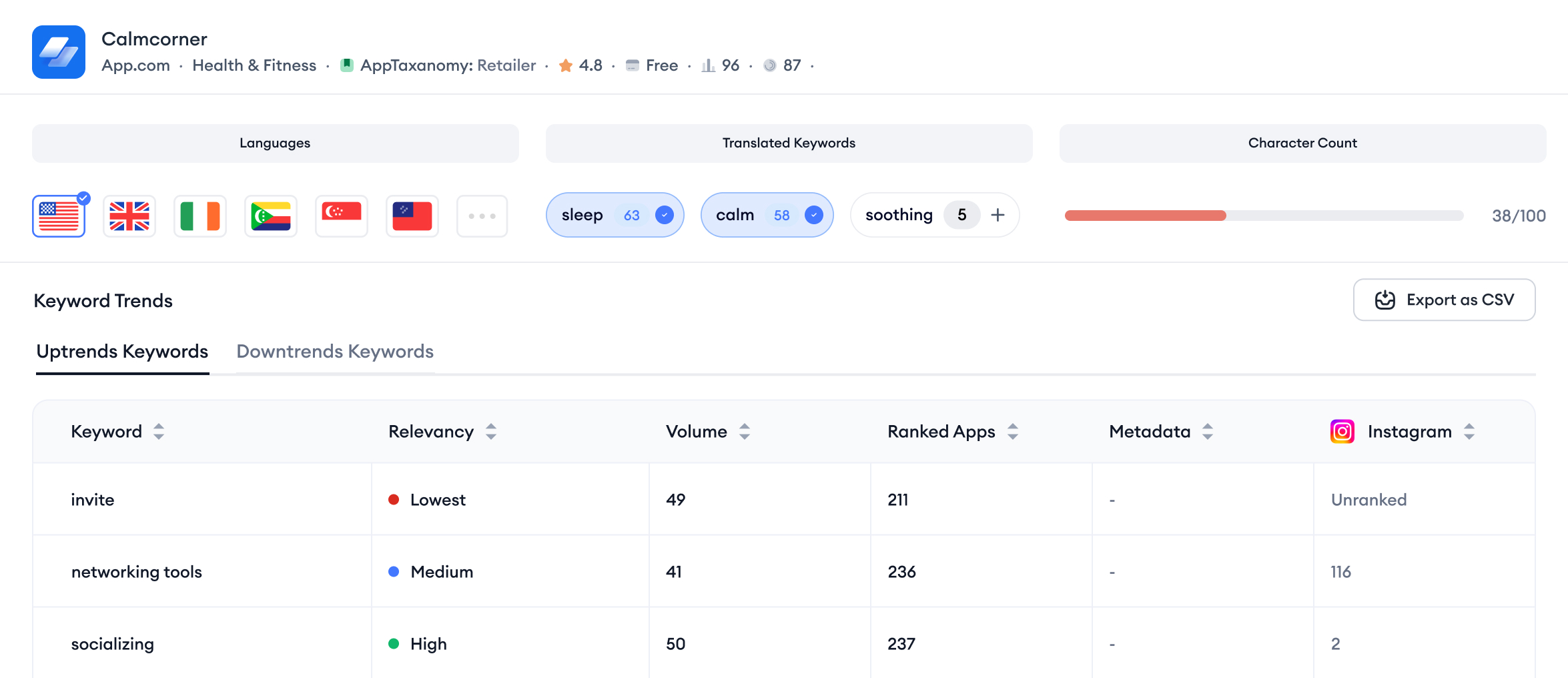
ASO keyword research is the foundation of App Store Optimization. It’s the process of finding and analyzing the search terms that potential users type into the App Store or Google Play when looking for apps like yours. The goal is to understand user intent, identify high-impact keywords, and strategically use them to boost your app’s visibility and installs.
Think of it as SEO for apps, just as websites compete for search engine rankings, apps compete for visibility in app store search results. The right keyword strategy helps your app appear in front of the right audience at the right time.
ASO keyword research metrics you need to be aware of
Before diving into the process, let’s summarize the key metrics for ASO keyword research. Understanding these will help you evaluate and prioritize keywords effectively:
-
Search popularity
Search popularity means how often users search for a given term. Higher search volume means a keyword has more potential traffic. For example, a popular word like “photo editor” will have a high search volume, indicating many users look for it. You generally want keywords that people actually search (no volume = no traffic), but volume alone isn’t enough.
-
Keyword difficulty
Keyword difficulty means how hard it is to rank for the keyword. Some ASO tools provide a difficulty score (or conversely a “chance” score) reflecting the level of competition. A very competitive keyword (like “music”) will be difficult for a new app to rank highly, whereas a niche long-tail term might be easier.
-
Keyword relevance
Keyword relevance means how closely the keyword relates to your app’s core purpose and features. It’s critical to choose relevant keywords that genuinely describe what your app offers. Targeting irrelevant but popular terms won’t help conversions. Users might see your app, but they won’t download it if it doesn’t meet their needs.
-
Keyword ranking
Keyword ranking means where your app (and competitors) rank for the keyword currently. This is more of a performance metric, but it guides strategy. For keywords you already target, know your rank. If you’re already ranking well for a term, you might focus on boosting it to #1 or #2. If you’re not ranking at all for a high-value keyword, that’s an opportunity, or a sign the keyword might be too competitive without more effort. Tracking ranking positions over time is vital to see the impact of your ASO changes.
| Metric | What it measures | Why it matters |
| Search popularity | User demand | Determines potential traffic |
| Keyword difficulty | Competition | Helps assess how realistic ranking is |
| Keyword relevance | Keyword-app fit | Ensures conversions, not just clicks |
| Keyword ranking | Current position | Tracks performance and oppurtunities |
By tracking these metrics, you get a complete picture of a keyword’s value. Next, let’s apply these concepts in a step-by-step process for doing keyword research for ASO.
How to do keyword research for ASO
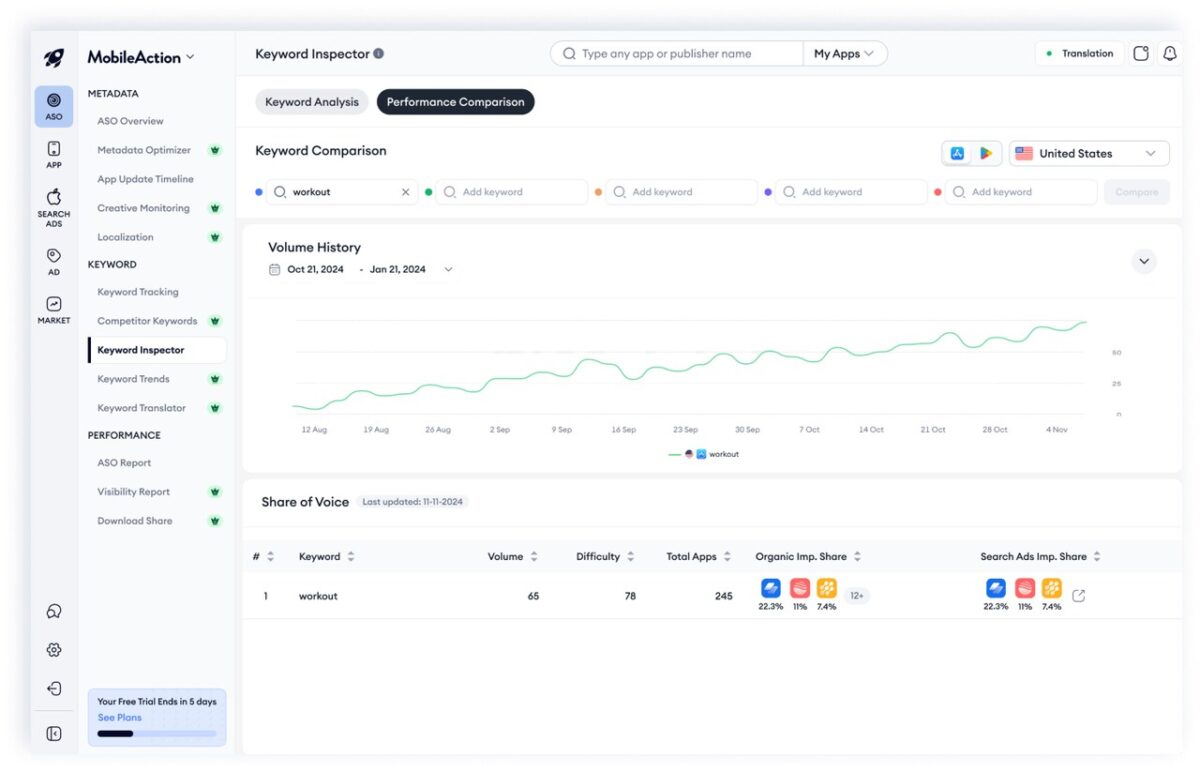
Effective keyword research for ASO is a structured, iterative process. Now, let’s check out these 8 steps to do a solid ASO keyword research for your app in 2025:
-
Step 1: Define your goals and audience
Every successful ASO strategy starts with clarity on goals and target audience. Before jumping into keyword lists, take time to consider what you want to achieve and who you’re trying to reach:
- Set your primary goals: Identify what you want from your ASO efforts. Are you aiming to increase overall installs? Expand into new regional markets? Are you trying to find a trendy keyword to build an app on it? Reach a different user demographic or improve your app’s category ranking? Your goals will influence which keywords matter. For example, if your goal is expanding to a new market (say, Latin America), you’ll be focusing on localized Spanish/Portuguese keywords. If the goal is to boost download volume, you might target more high-traffic generic terms, whereas a goal of improving user quality might lean toward very niche, relevant terms. Defining goals helps you prioritize the kinds of keywords you need.
- Understand your audience and their intent: Think about who your ideal users are and how they would search. Users often describe benefits or problems rather than specific features. For instance, a budgeting app’s audience might search “how to save money” or “expense tracker” more often than the app’s exact feature names. Brainstorm what pain points or desires your app addresses for users.
-
Step 2: Brainstorm a broad keyword list
![]()
With goals and audience in mind, it’s time to generate an initial keyword list. This is a creative, expansive step before we narrow things down:
- List your app’s core features and benefits: Write down all the keywords that obviously relate to your app. Include feature terms (what the app does) and benefit terms (what the user gets). For example, if you have a fitness app, feature keywords might be “workout plans”, “step counter”.
- Expand with synonyms and long-tail phrases: For each concept, think of alternative words or more specific phrases a user might search. Users have many ways to describe the same idea. For instance, “to-do list app” could also be “task manager”, “productivity organizer”, or “reminder app”. Long-tail keywords (multi-word phrases) are especially valuable, they may have lower search volume, but often lower competition and higher intent.
- Consider variations and misspellings: Small differences can matter in search. Include plural forms (e.g., “workout” vs. “workouts”), spacing or hyphenation variations (some might search “photoeditors” as one word, others “photo editors”), and common misspellings of major terms or brand names if applicable. Also think about regional language differences (e.g,. “colour” vs “color”, “soccer” vs “football”).
-
Step 3: Discover new keyword opportunities
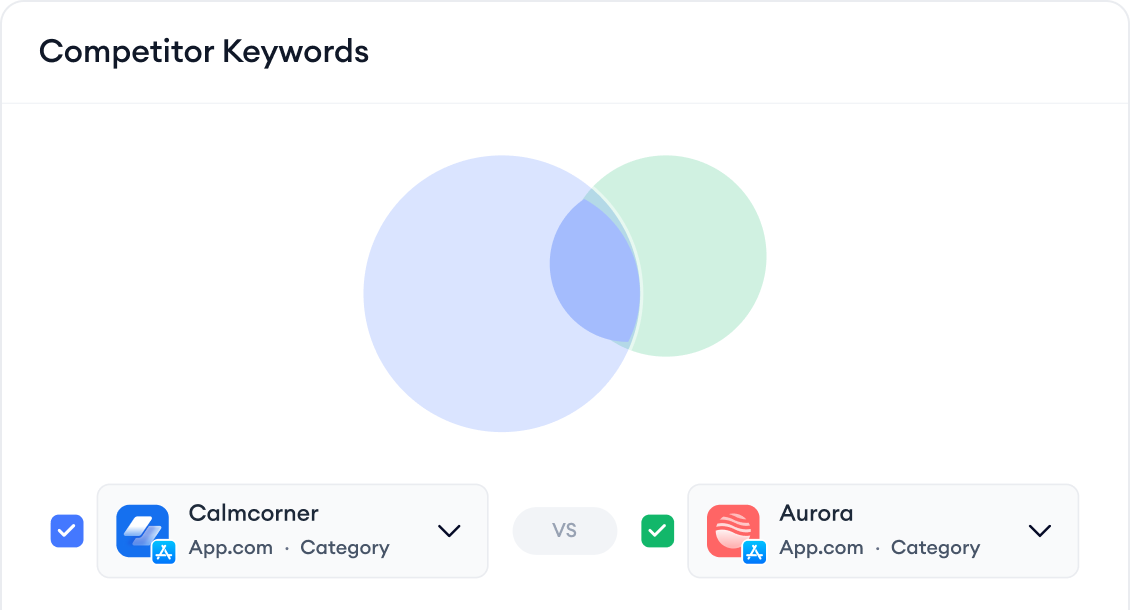
Once you have your basic list, it’s time to supercharge it with some help from ASO tools. Keyword discovery isn’t a one-time task; it’s an ongoing process that keeps your app competitive as market trends, user behavior, and search algorithms evolve.
To uncover new opportunities, explore the following approaches that remain effective year after year:
1. Analyze competitor rankings
A strong ASO strategy starts with understanding what’s working for others in your category. Competitor analysis helps you uncover which keywords drive visibility, installs, and conversion for top-performing apps, giving you a roadmap of opportunities to target.
With MobileAction’s Competitor Keywords, you can instantly understand how your app stacks up against competitors. This feature allows you to see which keywords your rivals rank for, which ones they’re missing, and where your app can fill those gaps to capture untapped traffic.
By tracking your competitors’ keyword performance over time, you can anticipate market shifts, identify new trends before they mature, and continuously refine your ASO efforts to stay ahead of the competition.
2. Track emerging search terms
User search behavior in app stores is constantly evolving, new trends appear overnight, while once-popular keywords lose traction as user needs change. Staying in tune with these dynamics is key to keeping your app visible and relevant throughout the year.
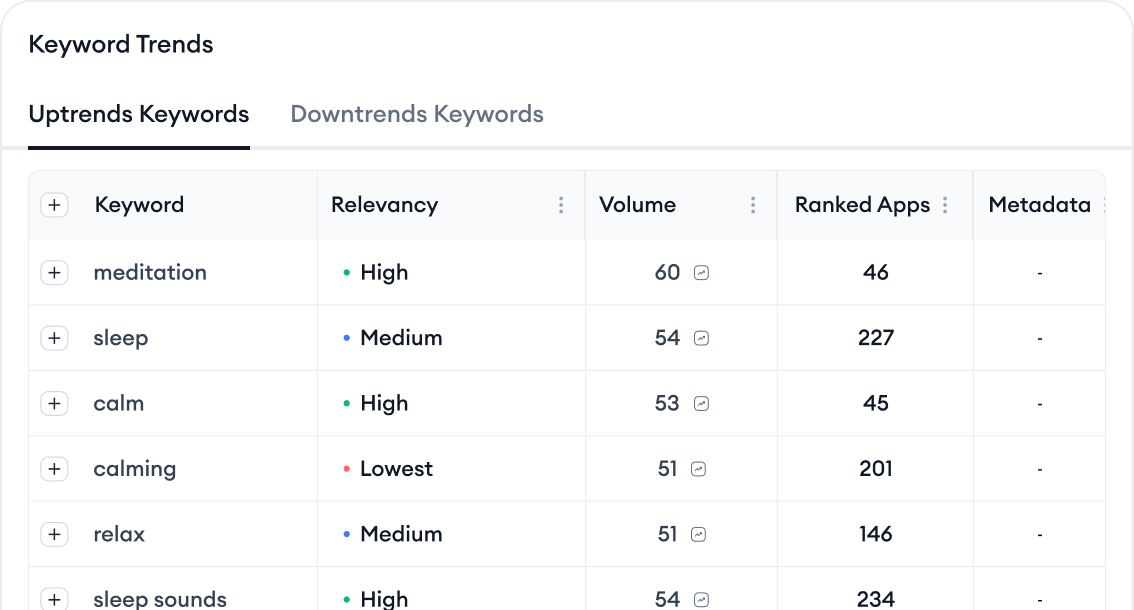
MobileAction’s Keyword Trends gives you a clear view of how keywords perform over time across different categories and markets. You can identify rising search terms before they become mainstream, allowing your app to gain early visibility while competition is still low. Likewise, spotting declining keywords ensures you don’t waste valuable metadata space on phrases that no longer convert.
By regularly analyzing keyword trajectories and popularity scores, you’ll be able to plan smarter updates for your app’s metadata, align campaigns with seasonal patterns, and maintain a sustainable flow of organic downloads.
3. Evaluate performance metrics
Every keyword in your list serves a different purpose; some drive visibility, others conversion. Knowing which ones truly matter requires accurate, comprehensive performance insights.
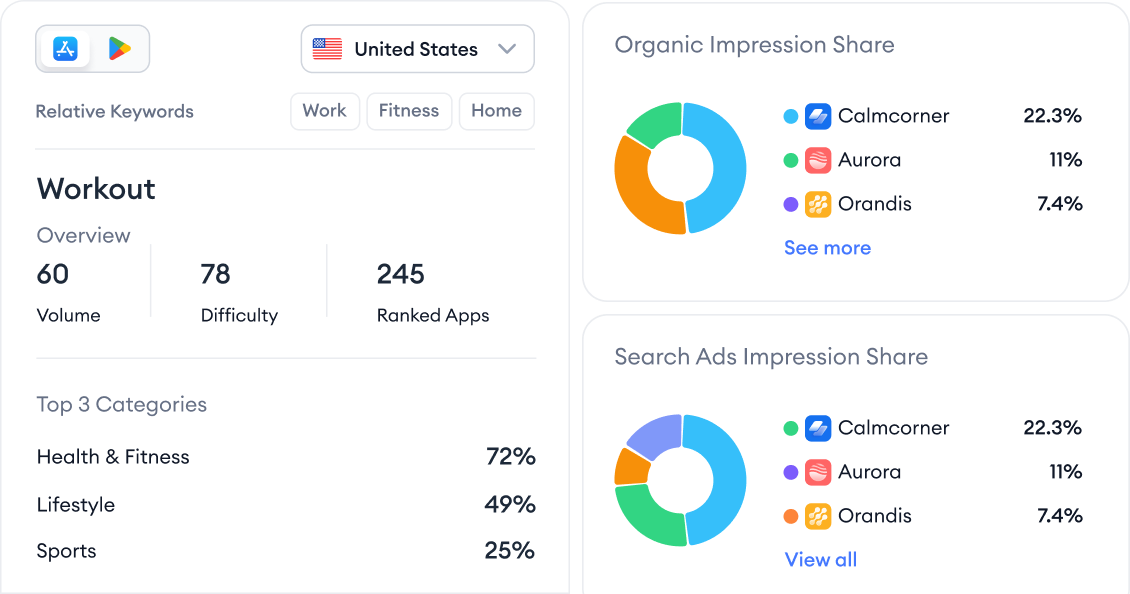
With MobileAction’s Keyword Inspector, you can analyze crucial keyword metrics like search volume, difficulty, relevance, and current ranking positions all in one unified view. This removes the guesswork and manual data collection that often slows down ASO workflows. The tool simplifies comparison between potential target keywords and gives you actionable insights on where to focus for the highest return.
By filtering out low-performing or irrelevant keywords, you can build a more strategic keyword portfolio that supports both short-term ranking gains and long-term visibility growth. Keyword Inspector enables you to make informed, data-backed optimization decisions with confidence.
4. Monitor changes over time
App Store algorithms, competitor rankings, and user behavior all evolve, sometimes daily. Consistent keyword monitoring ensures your app doesn’t lose momentum when these changes occur.
MobileAction’s Keyword Tracking is designed to simplify and streamline the keyword research and tracking process, bringing all keyword-related tasks into one intuitive workflow.
Instead of navigating between multiple pages, you can now discover, manage, and monitor keyword performance in a single, cohesive dashboard, eliminating redundancy and enhancing overall usability.
Using MobileAction’s ASO Intelligence tools, you can rapidly expand and refine your initial list. By the end of this step, you should have a much richer pool of keyword candidates, including not just the ones you brainstormed, but also new gems suggested by data and competitive insights. Now, the challenge is to analyze and narrow down this list to the keywords that will make the biggest impact.
Step 4: Analyze keywords: Relevance, difficulty and potential
At this stage, you likely have a large list of potential keywords. Now your goal is to assess each keyword’s relevance, difficulty, and potential value for your app:
Go through your list and mark how relevant each term is to your app. Any keyword that isn’t clearly relevant to your app’s functionality or audience’s intent should be questioned.
For the remaining relevant keywords, look at the search volume and difficulty scores. This is where you balance opportunity and competition. In reality, many high-volume keywords will also be highly competitive (low chance). It’s a strategic decision: you might still include a few big, competitive keywords (especially if they’re very relevant), but your whole list shouldn’t be only the hardest ones.
If your app is a perfect match for the keyword (e.g. someone searches “budget planner” and you’re literally a budget planner app with strong ratings), the conversion potential is high. If the keyword is somewhat related but not a core feature, potential might be lower.
-
Step 5: Select the right keywords
Now comes the part of choosing the final set of keywords to target in your app’s metadata (title, subtitle, keyword field, etc.). This requires balancing popularity and competition, and creating a well-rounded keyword list for your app:
- Balance high-volume vs. long-tail: Aim for a mix of high-volume keywords and long-tail keywords. The broad terms can bring big traffic if you manage to rank, but they often have fierce competition. A strategic mix might include a couple of “big” keywords, a larger set of medium-traffic ones, and plenty of long-tails
- Watch competitor movements and trends: When selecting keywords, consider what your competitors are doing. If all your competitors target the exact same high-volume word, competing there will be hard. You might find better success targeting a related niche they’ve overlooked. Keep an eye on emerging keywords too.
By the end of Step 5, you should have a well-curated keyword list: the target keywords you’ll actually implement in your app’s metadata. This list is a balance of “popular enough” and “winnable” terms for your app’s audience.
-
Step 6: Implement keywords in your metadata
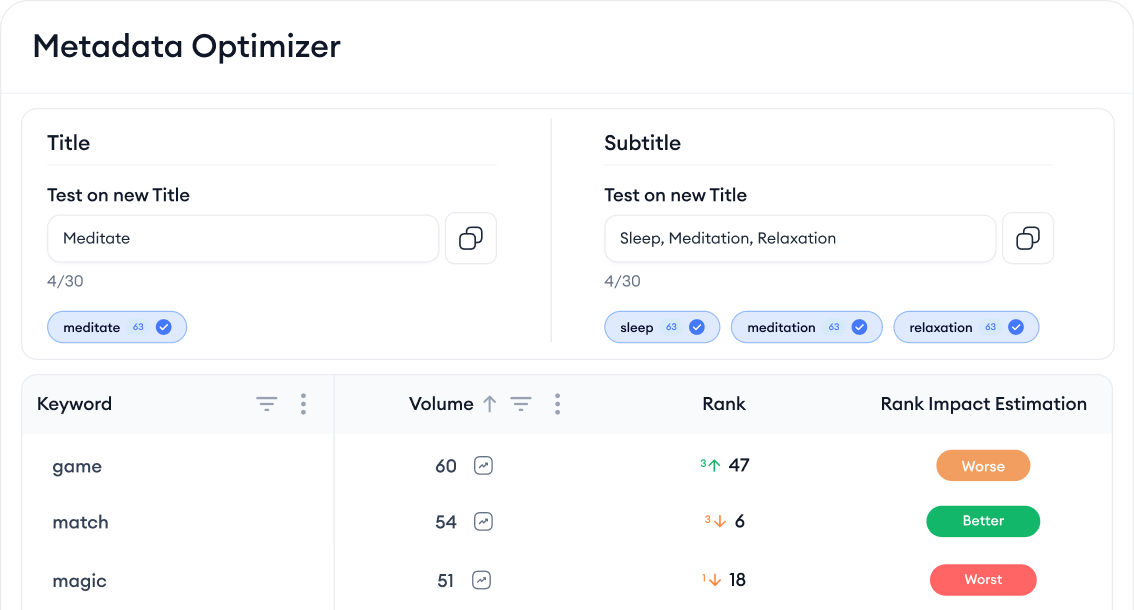
Choosing the right keywords is only half the work; you also need to implement them effectively in your app store metadata. This means placing keywords in the optimal fields of your app’s listing and doing so in a natural, user-friendly way. Here are the best practices for integrating keywords into your metadata:
- App Title (Name): The title is the most heavily weighted field for ASO. It should include your most important keyword(s) if possible. On Apple’s App Store you have up to 30 characters, and on Google Play up to 50 characters for the App title, so use that space wisely.
- Subtitle / Short Description: Apple’s App Subtitle (30 characters) and Google Play’s Short Description (80 characters) are ideal to include more high-priority keywords. Think of the subtitle/short description as a concise slogan that highlights your app’s value proposition and contains a couple of your target keywords.
- Keyword Field (Apple) / Additional Keywords: If you’re on iOS, the keywords field (100 characters, not visible to users) is where you list extra keywords separated by commas. Use it to include relevant keywords that you couldn’t fit in the title or subtitle. You don’t need to repeat words that are already in your title/subtitle, as Apple’s indexing will already count those. Use the comma-separated space efficiently: no need for spaces or any connectors, just keywords. On Google Play, there isn’t a private keyword list field, but Google indexes the long description, so that’s where you’ll place additional keywords (more on that next). Both stores also allow you to specify tags or categories – ensure you select the proper category and tags for your app, as those can indirectly affect relevance in search.
- Long Description (Google Play): The long description (up to 4,000 characters on Google Play) is indexed for search on Google Play, so you want to weave your keywords throughout this text in a natural way. In your Google Play description, aim to include all your important keywords a few times each, especially in the first and last paragraphs
Step 7: Localize your keyword research
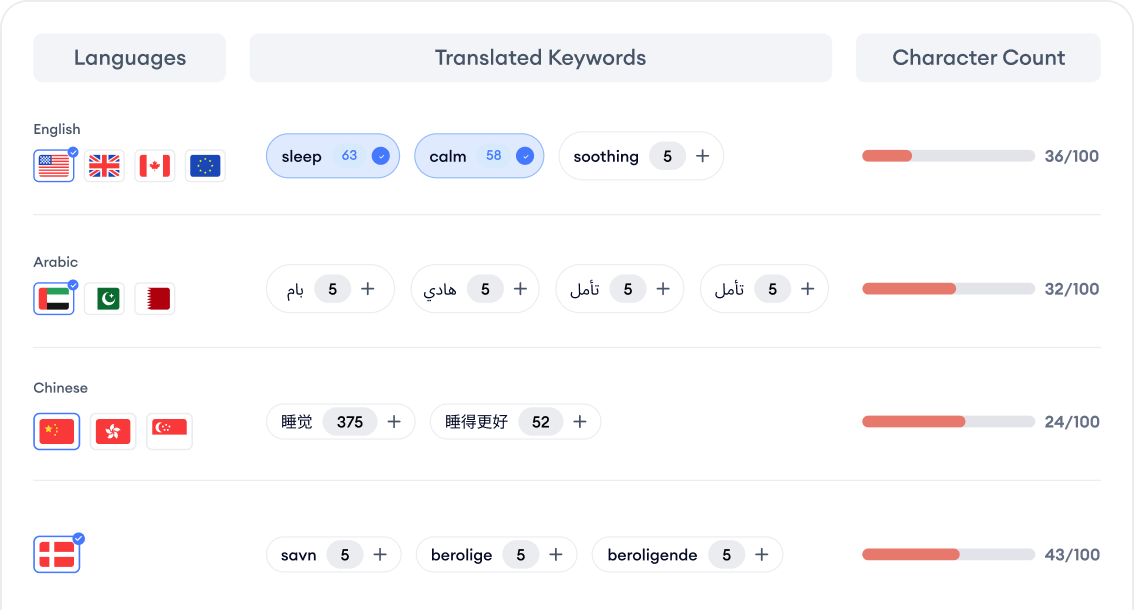
In 2025, app growth often means going beyond your home market. Localization of your ASO keyword research is crucial if you want to reach users in different languages or regions. Simply put, you need to do ASO in each target locale, because users search in their own language and with culturally specific terms. Here’s how to localize your keyword research effectively:
- Translate and research keywords for each target language: Start by translating your core keywords into the local language of each market you’re targeting. But don’t stop at direct translations, different markets might use different phrases. For example, an American English keyword “soccer game” would be “football game” in British English.
With Keyword Translator, you can optimize titles, subtitles, and descriptions for global audiences by translating app metadata into various languages. It helps ensuring resonance across diverse markets by tailoring the App Store and Google Play Store presence to speak to 20+ different countries and languages.
Localization by MobileAction provides an overview of which ASO elements of an app (such as title, subtitle, and description) have been localized. It offers insights into how well the app performs in each country in which it’s active.
- Adapt to cultural nuances: Localization isn’t just literal translation. It’s important to understand cultural usage. For example, a finance app targeting the Middle East might find that “Zakat calculator” is a crucial keyword during certain seasons (related to charitable giving in Islam), whereas that term would be irrelevant elsewhere. Or a slang term might be more commonly used than the formal term for a concept. If possible, consult native speakers or hire localization experts to validate keyword choices.
- Localize your app listing content: Once you have the keywords, localize your app title, subtitle, description, etc., to include those keywords. Both Apple and Google allow you to have separate metadata for different locales (Apple via adding localizations in App Store Connect; Google via listing translations). Use that to your advantage.
By localizing your ASO, you unlock potentially huge new user bases. Many app markets around the world are less saturated with ASO-optimized apps, so a little effort can go a long way..
Translation can surface valuable keywords that drive more installs, so invest the time in this step. MobileAction’s support for multi-language research and tracking will make the process much more data-driven, as you can validate the search volumes and track rankings per locale.
-
Step 8: Monitor performance and iterate
Congratulations, you’ve implemented your optimized keywords! But ASO keyword research doesn’t end there. One of the most important things to understand is that ASO is an ongoing process, not a one-time task.
To maintain and improve your rankings, you need to continuously monitor how your keywords are performing and iterate on your strategy. Here’s how to do that:
- Track your keyword rankings and metrics: Set up keyword tracking to monitor where your app ranks for all your target keywords on an ongoing basis. MobileAction’s Keyword Tracking dashboard will show you daily rankings for your app on each keyword, and often your competitors’ rankings too. Check these regularly.
- Refine your keyword list regularly: Treat your keyword list as dynamic. Every few weeks or months, reevaluate it. Remove underperforming keywords, those that you’ve tried but just aren’t yielding results (no good ranking, or good ranking but no conversions). There’s an opportunity cost to keeping them if they’re displacing other terms in your metadata. At the same time, add new keywords that show promise. Maybe through monitoring you found new search queries rising in popularity, or your competitors started targeting a term you hadn’t.
- Watch your competitors: Continue to monitor competitor apps as well. MobileAction allows you to track competitors’ keyword rankings and even suggests competitor keywords to consider. If a competitor suddenly jumps ahead of you for an important keyword, you may need to respond.
Common ASO Keyword Research mistakes
Even experienced marketers can make missteps during the ASO keyword research process. Recognizing these common mistakes early helps you build a stronger ASO foundation:
1. Targeting irrelevant but high-volume keywords
A common mistake is focusing on keywords solely because they have high search popularity. While a large search volume can seem attractive, targeting irrelevant keywords leads to poor conversion rates and wasted visibility.
Users who land on your app through unrelated searches are less likely to install. Always evaluate whether the keyword truly reflects your app’s functionality and value proposition.
2. Ignoring keyword difficulty and competition
High-volume keywords often come with intense competition. If you’re a newer app or have limited visibility, targeting the most competitive terms will rarely yield results. Instead, analyze difficulty or “chance” scores to strike a balance between opportunity and feasibility.
3. Not balancing short-tail and long-tail keywords
Many developers chase short, generic keywords like “fitness” or “music,” forgetting that users frequently search with longer, more specific phrases such as “home workout planner” or “offline music player.”
Long-tail keywords tend to have lower competition and higher conversion intent. Combining short-tail and long-tail terms in your ASO keyword list ensures broader yet more qualified reach.
4. Forgetting to localize keywords
Localization is often underestimated in ASO keyword research. Translating and adapting your keywords for each region allows your app to appear in local search results and connect with users in their native language.
Tools like Keyword Translator and Localization help identify the most relevant local terms and track performance per market. Ignoring this step can severely limit your app’s global growth potential.
5. Set-and-forget keyword strategy
App Store algorithms and user behavior evolve constantly. Keyword popularity fluctuates, competitors shift strategies, and new search patterns emerge. If you set your keywords once and never revisit them, your rankings will likely decline.
Successful teams treat ASO keyword research as an ongoing optimization process, reviewing rankings, testing new keywords, and updating metadata regularly using Keyword Tracking.
6. Overstuffing metadata
Stuffing every possible keyword into your title, subtitle, or description may seem like a shortcut to higher rankings, but it often backfires. Apple and Google prioritize readability and user experience. Overstuffing not only hurts your conversion rate but may also make your listing appear spammy. Instead, integrate keywords naturally and focus on clear, persuasive messaging that highlights your app’s benefits.
To learn more about the common ASO mistakes, you can check out our article titled ASO mistakes that are killing your app growth in 2025
Bringing it all together: A smarter ASO approach
In 2025, effective ASO keyword research is not a set-and-forget task; it’s a living, data-driven process that balances relevance, difficulty, and conversion potential.
We’ve seen how understanding your audience, building a smart keyword list, leveraging tools for insights, and continually refining your approach can dramatically improve your app’s search rankings.
The key takeaways are clear: focus on keywords that matter, implement them strategically, and keep optimizing over time with real performance data as your guide.
The great news is you don’t have to do this alone or manually. MobileAction’s ASO Intelligence provides all the tools we discussed, from Keyword Inspector and Keyword Tracking to Keyword Trend and Keyword Translator, to turn ASO keyword research into real, tangible growth for your app.
With MobileAction, you can uncover those high-impact keywords you’ve been missing, monitor your competitors, and optimize your metadata with confidence, all in one place.
Don’t let your app get lost in the crowd. Start a free trial today and experience how easy it is to find the right keywords and implement them for better rankings.
Frequently Asked Questions
How to do ASO keyword research?
To do ASO keyword research, start by defining your app’s goals and understanding your target audience’s search intent. Then, brainstorm relevant keywords related to your app’s features and benefits. Use ASO tools like MobileAction’s ASO Intelligence to expand your list, analyze search volume, difficulty, and relevance, and identify the most promising opportunities. Next, select a balanced mix of high-volume and long-tail keywords, implement them naturally in your metadata (title, subtitle, and description), and track performance over time.
How to do keyword research for ASO?
Doing keyword research for ASO involves combining creativity and data. Start by listing all terms your potential users might search for, including synonyms, variations, and long-tail phrases. Then, use MobileAction’s Keyword Inspector, Competitor Keywords, and Keyword Trends to uncover new keyword opportunities and understand what drives visibility in your category. Evaluate each keyword’s popularity, difficulty, and relevance, select those that align with your goals, and include them strategically in your app’s metadata.
Looking to boost your app's visibility and acquire more users? Our 2025 ASO Report is your ultimate guide to navigating the evolving app store landscape. Packed with data-driven insights, keyword trends, and top-ranking app strategies, this report will equip you with the knowledge to optimize your app's presence and achieve organic growth.





































